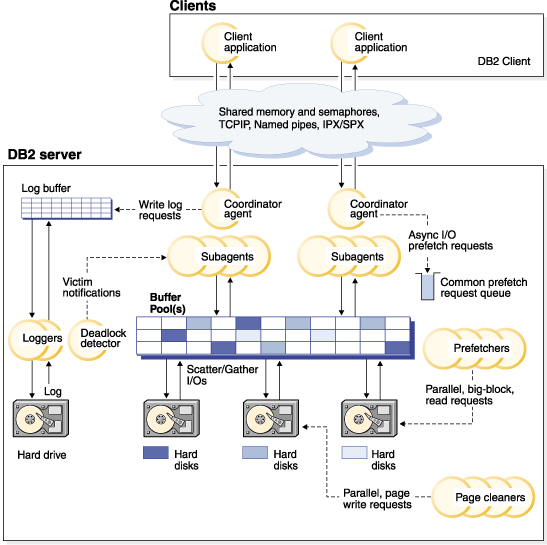Db2 architecture and process overview
On the client side, local or remote applications are linked with the Db2 client library. Local clients communicate using shared memory and semaphores; remote clients use a protocol, such as named pipes (NPIPE) or TCP/IP. On the server side, activity is controlled by engine dispatchable units (EDUs).

EDUs are implemented as threads on all platforms. Db2 agents are the most common type of EDU. These agents perform most of the SQL and XQuery processing on behalf of applications. Prefetchers and page cleaners are other common EDUs.
A set of subagents might be assigned to process client application requests. Multiple subagents can be assigned if the machine on which the server resides has multiple processors or is part of a partitioned database environment. For example, in a symmetric multiprocessing (SMP) environment, multiple SMP subagents can exploit multiple processors.
All agents and subagents are managed by a pooling algorithm that minimizes the creation and destruction of EDUs.
Buffer pools are areas of database server memory where pages of user data, index data, and catalog data are temporarily moved and can be modified. Buffer pools are a key determinant of database performance, because data can be accessed much faster from memory than from disk.
- Prefetchers retrieve data from disk and move it into a buffer pool before applications need the data. For example, applications that need to scan through large volumes of data would have to wait for data to be moved from disk into a buffer pool if there were no data prefetchers. Agents of the application send asynchronous read-ahead requests to a common prefetch queue. As prefetchers become available, they implement those requests by using big-block or scatter-read input operations to bring the requested pages from disk into the buffer pool. If you have multiple disks for data storage, the data can be striped across those disks. Striping enables the prefetchers to use multiple disks to retrieve data simultaneously.
- Page cleaners move data from a buffer pool back to disk. Page cleaners are background EDUs that are independent of the application agents. They look for pages that have been modified, and write those changed pages out to disk. Page cleaners ensure that there is room in the buffer pool for pages that are being retrieved by prefetchers.
Without the independent prefetchers and page cleaner EDUs, the application agents would have to do all of the reading and writing of data between a buffer pool and disk storage.